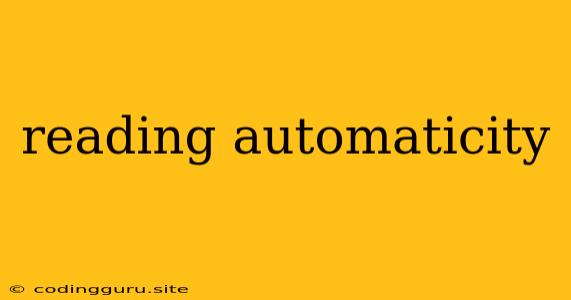What is Reading Automaticity and Why is it Important?
Reading automaticity is a crucial aspect of reading proficiency that allows readers to decode words effortlessly and quickly. It's not just about reading fast; it's about reading fluently and with understanding. When a reader achieves automaticity, they can focus their cognitive energy on comprehending the text rather than struggling with individual words.
How Does Reading Automaticity Develop?
Reading automaticity develops over time through consistent practice and exposure to text. It involves several key elements:
- Word Recognition: This refers to the ability to identify words quickly and accurately, without having to sound them out.
- Phonics Skills: A strong foundation in phonics helps students decode unfamiliar words and build a vocabulary.
- Fluency: Fluency encompasses both speed and accuracy in reading, enabling readers to maintain comprehension while reading at a comfortable pace.
- Sight Words: These are common words that readers learn to recognize instantly, reducing the cognitive load during reading.
The Benefits of Reading Automaticity
A high level of reading automaticity brings numerous benefits:
- Improved Comprehension: When readers are not bogged down by decoding challenges, they can allocate their cognitive resources to understanding the meaning of the text.
- Enhanced Reading Enjoyment: Fluency makes reading more pleasurable, encouraging students to engage with more complex texts and expand their reading horizons.
- Increased Vocabulary: Automaticity allows readers to encounter more words, contributing to vocabulary development and a deeper understanding of language.
- Stronger Writing Skills: Proficiency in reading directly impacts writing skills, as students develop a better understanding of sentence structure, word choice, and grammar.
How to Promote Reading Automaticity
There are several strategies that can help foster reading automaticity in students:
- Provide Repeated Reading Opportunities: Encourage students to reread familiar texts to increase fluency and accuracy.
- Introduce Sight Word Activities: Games, flashcards, and other engaging activities can help students memorize common words.
- Focus on Phonics Instruction: Develop strong phonics skills through systematic instruction and practice.
- Use Guided Reading: Provide opportunities for students to practice reading with support from a teacher or tutor.
- Model Fluent Reading: Demonstrate fluent reading by reading aloud expressively and engagingly.
- Create a Positive Reading Environment: Encourage a love of reading by providing access to a variety of books and creating a supportive atmosphere.
Assessing Reading Automaticity
Several tools can be used to assess reading automaticity in students, including:
- Informal Reading Inventories: These assessments measure a student's reading level and identify areas for improvement.
- Fluency Checks: Students read a passage aloud, and the teacher records their reading rate, accuracy, and prosody.
- Running Records: This assessment involves recording a student's reading performance on a specific text, noting errors and strategies used.
Addressing Reading Automaticity Challenges
Students who struggle with reading automaticity may need additional support and interventions.
- Individualized Instruction: Provide tailored instruction based on a student's specific needs and challenges.
- Multisensory Learning: Incorporate different senses (visual, auditory, kinesthetic) to reinforce learning and engage students.
- Technology Tools: Utilize assistive technology, such as reading software or audiobooks, to provide support and enhance reading experiences.
Conclusion
Reading automaticity is a fundamental skill that underpins reading comprehension and fluency. It's crucial to nurture this skill in young readers, providing them with the tools and support they need to develop confident and proficient reading habits. By fostering a love of reading and encouraging consistent practice, we can equip students with the skills they need to unlock the world of literacy and achieve their full potential.
